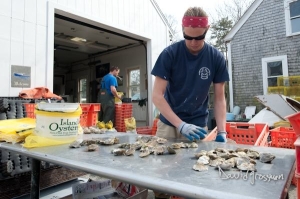What could possibly go wrong?
It turns out, almost everything. We've had something of a black cloud following us these last few weeks. It's nothing serious but there's been a string of bad luck and I'm hoping the streak is almost over. It started a week and half ago when a lightning storm hit way too close to home. Our crew had been on the float wrapping up an epic bag count last Thursday morning and came in to shore to drop the bags off. The rain hit right as we got back to land so we took a quick break and waited for the heavy stuff to pass. An hour or so later, we were back on the dock where Catie and I were pulling out silos getting prepped to grade some seed. The sky got dark again and Berg made the call: Head indoors. Now.
I ran over to the rowing dock to help Catie get some stuff situated and passed Christian who was trying to get his silos in a safe place. He stayed on the dock but Catie and I made it up to the woodshed with Maggie, Eva, Will, and Berg. Berg ran back out for something and while he was gone, the rain picked up. A few minutes later, a huge clap of thunder crashed over our heads. At the same time, I looked towards the wood shed door and saw a pink flash. Lightning strike. And it was close. We all hit the deck waiting for another boom but instead, the door opened and in came Christian and Berg, looking scared shitless. The lightning had hit a sailboat mast that was moored about 20 yards from the rowing dock. Christian had seen the sky turn pink and did a belly flop onto the plastic part of the dock. He said he could smell the electricity from where he was. Steve of Jeeves was in the process of rowing from Billy's float back to land and was within a few feet of the sailboat that got struck. Very close call but thankfully, no one was hurt (not so sure about the sailboat, though).
The next day, Berg got hit by a car. (He's still on crutches but we're hoping to see him back on the farm this week.)
The 4th, from what I hear, was pretty spectacular. Some of the crew plus a few growers along with friends got some fireworks lit from the float (Dave got a great shot of it).
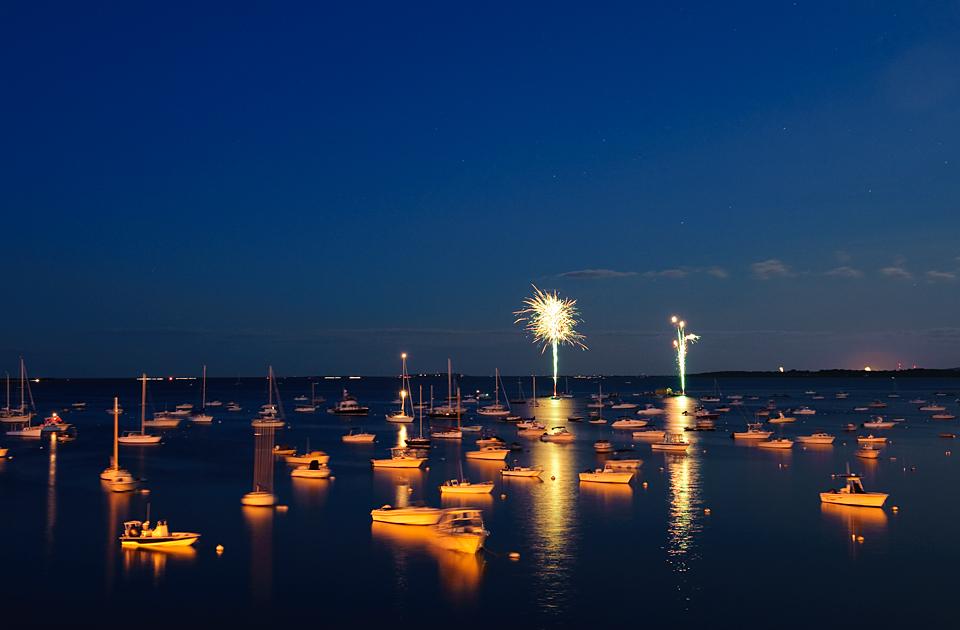
And then this past week, we had another round of bad luck. Skip came down with a stomach bug (after chipping his tooth on a bagel). We couldn't manage to shake the bad weather until Thursday this week. And our white boat, the Carolina, decided to die while I was about to drive it from the float back to shore. The motor turned twice and then just cut out. I was already untied and couldn't do anything but stand there, fussing with the throttle, watching folks on the float watch me drift away. Thankfully, the current carried me over to a nearby moored sailboat so I tied myself up and waited for Mark to get out there to rescue me (he called me a good mariner; "at least you got yourself tied up to something"). I was also pretty thankful that the problem wasn't something I had caused. I think it ended up being a fuse or faulty wire, but either way, the Carolina is out of commission until next week. As Greg Morris said, "If you're going to work on the water, better know a thing or two about how to fix a boat."
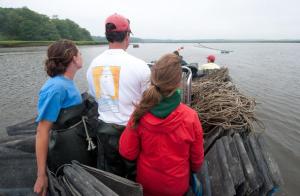
Skip was still pretty out of it on Friday but we managed to do a double deploy: we got about 600 bags out to both the river and the middle of the bay during low tide. One team went to the river, the other went to the cages and we all had a pretty successful morning. Finally: the babies are in the water! We still have more to get out there but I think we're officially over the hump.
 We had a record-breaking hot one yesterday: it hit 91 in Boston and we were in the high 80s on the water all day. My crew was out on the tide by 7 and around 8, the heat picked up and those huge rubber waders felt like lead. But it was a super long tide so we got lots of picking done, despite the dreaded weed that still covers everything. And, despite this friendly little spider crab who I almost picked up since he was disguised as an oyster.
We had a record-breaking hot one yesterday: it hit 91 in Boston and we were in the high 80s on the water all day. My crew was out on the tide by 7 and around 8, the heat picked up and those huge rubber waders felt like lead. But it was a super long tide so we got lots of picking done, despite the dreaded weed that still covers everything. And, despite this friendly little spider crab who I almost picked up since he was disguised as an oyster. 

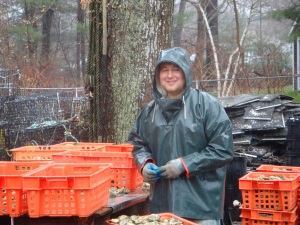 We're seeing buds on the trees and now we've got growth on our oysters. We were stuck up at the shop yesterday due to weather but it gave us a nice break from the water and chance to catch up with all of the folks who wander in and out of the garage all day. The morning started with culling and listening to CJ's crazy weekend stories while he and Cory loaded up the truck. As Cory would say, "The kid's on fire." Shore joined us for a bit (looking every bit as haggard as CJ) and we got to chat with Billy who just got back from vacation. He was telling us about the weather diary he's kept for the last several years - says the water temps are probably up to about 40 degrees right now. I asked if he'd seen the weather trending one way or the other in general over the last few years and he said no, not really. "There are cycles here and there but for the most part, it's been the same. But we have had some pretty bad nor'easters at the end of April these past few years." Fingers crossed this year's an off one.
We're seeing buds on the trees and now we've got growth on our oysters. We were stuck up at the shop yesterday due to weather but it gave us a nice break from the water and chance to catch up with all of the folks who wander in and out of the garage all day. The morning started with culling and listening to CJ's crazy weekend stories while he and Cory loaded up the truck. As Cory would say, "The kid's on fire." Shore joined us for a bit (looking every bit as haggard as CJ) and we got to chat with Billy who just got back from vacation. He was telling us about the weather diary he's kept for the last several years - says the water temps are probably up to about 40 degrees right now. I asked if he'd seen the weather trending one way or the other in general over the last few years and he said no, not really. "There are cycles here and there but for the most part, it's been the same. But we have had some pretty bad nor'easters at the end of April these past few years." Fingers crossed this year's an off one. 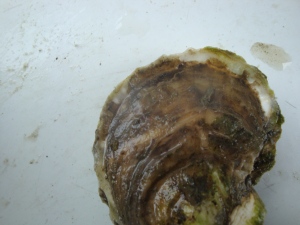
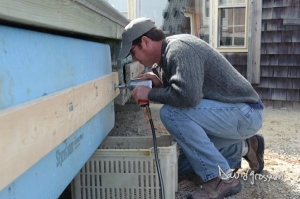
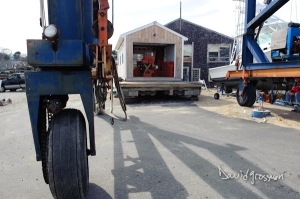
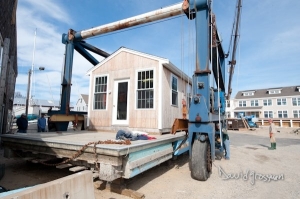
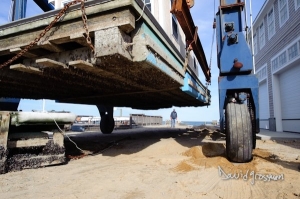
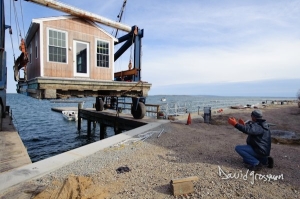
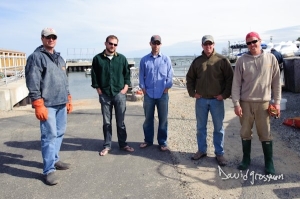
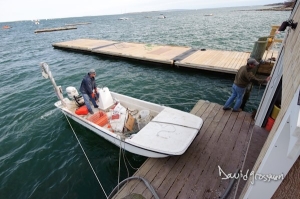
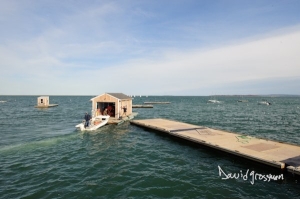
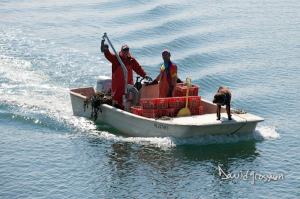
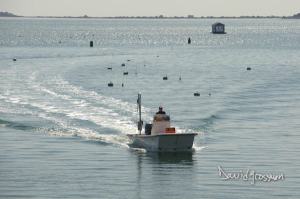
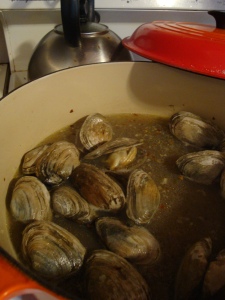 Before I left the farm on Friday afternoon, Skip asked if any of us wanted steamers. Well, obviously, yes we did. We waited for him to come back from the water and pull a huge basket of steamer clams out of the back of his truck. The Andy's and I loaded up bags of the freshly dug clams before heading to the garage where Skip was pulling scallops out of the cooler. "Help yourselves," he said. pointing his thumb to a 20-pound bag of shucked scallops. These were the dayboats Island Creek has just started selling and they were so fresh, we were eating them raw out of the bag (the fisherman who sold them to us shucks them while he's dragging - all in a one-man operation). Each one was sweet and meaty with the perfect amount of soft, chewy bite.
Before I left the farm on Friday afternoon, Skip asked if any of us wanted steamers. Well, obviously, yes we did. We waited for him to come back from the water and pull a huge basket of steamer clams out of the back of his truck. The Andy's and I loaded up bags of the freshly dug clams before heading to the garage where Skip was pulling scallops out of the cooler. "Help yourselves," he said. pointing his thumb to a 20-pound bag of shucked scallops. These were the dayboats Island Creek has just started selling and they were so fresh, we were eating them raw out of the bag (the fisherman who sold them to us shucks them while he's dragging - all in a one-man operation). Each one was sweet and meaty with the perfect amount of soft, chewy bite. 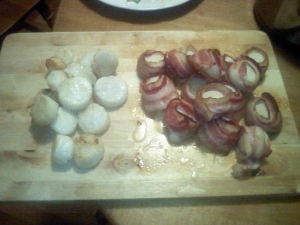
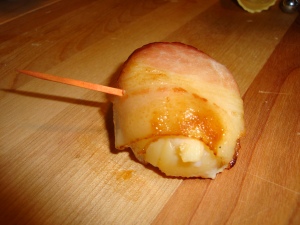
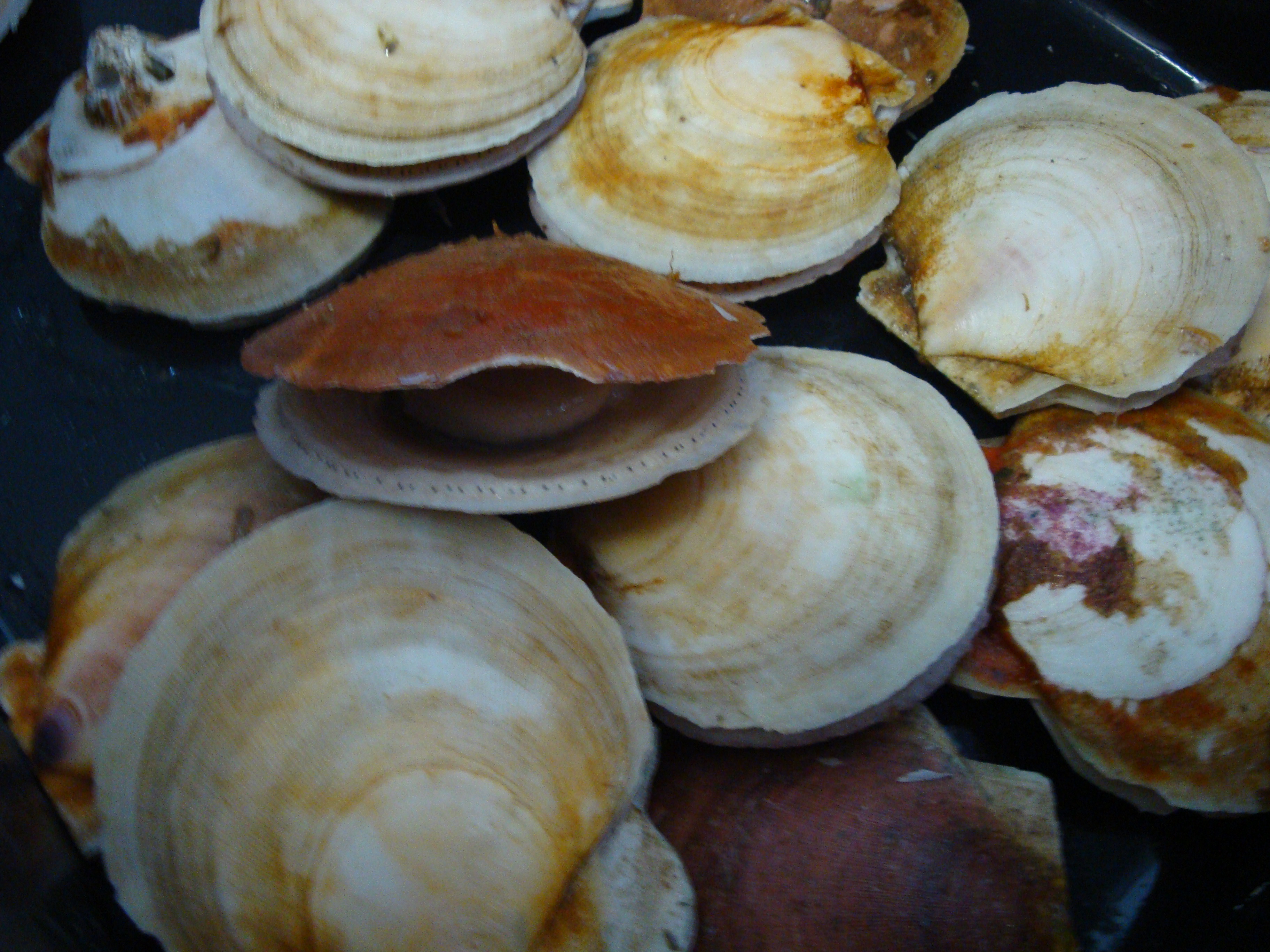
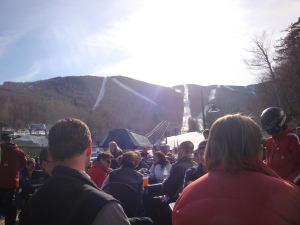 Officially, we hit spring at 7:44 a.m. on Friday morning, but you wouldn't have known it in Vermont this weekend. I went up to Sugarbush with my college friends, Karen, Co & Meg and while we had a fantastic, 40-degree sunburner on the slopes yesterday, we woke up to two inches of fluffy white stuff this morning. Thankfully, it was clear and dry here in Boston when I got home today.
The first day of spring on the farm meant 30-degree temps and a bright, clear day. When I got to the shop Friday morning, I met up with A2 and our new comrade, Claudio, and then grabbed a ride down to the water with Skip. Along the way, we chatted about how things were going so far (good but physically grueling) and started to get into his own personal connection to the seasons. He said a friend once told him that he was more in tune with the seasons than anyone else she'd known. And he agreed.
Officially, we hit spring at 7:44 a.m. on Friday morning, but you wouldn't have known it in Vermont this weekend. I went up to Sugarbush with my college friends, Karen, Co & Meg and while we had a fantastic, 40-degree sunburner on the slopes yesterday, we woke up to two inches of fluffy white stuff this morning. Thankfully, it was clear and dry here in Boston when I got home today.
The first day of spring on the farm meant 30-degree temps and a bright, clear day. When I got to the shop Friday morning, I met up with A2 and our new comrade, Claudio, and then grabbed a ride down to the water with Skip. Along the way, we chatted about how things were going so far (good but physically grueling) and started to get into his own personal connection to the seasons. He said a friend once told him that he was more in tune with the seasons than anyone else she'd known. And he agreed. 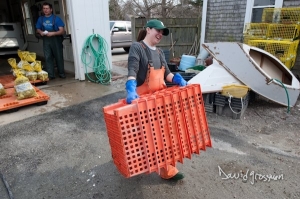
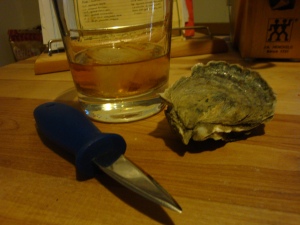
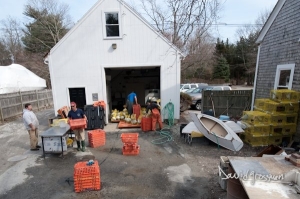 Can't believe it's Friday already. This week flew. Wednesday was a perfect day: high 50s, sunny, windy. We finished up our bags yesterday and have a new guy joining our crew today. Berg is out of town so A2, Claudio, and I are on our own today.
Can't believe it's Friday already. This week flew. Wednesday was a perfect day: high 50s, sunny, windy. We finished up our bags yesterday and have a new guy joining our crew today. Berg is out of town so A2, Claudio, and I are on our own today. 